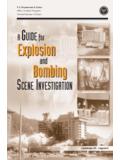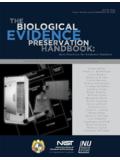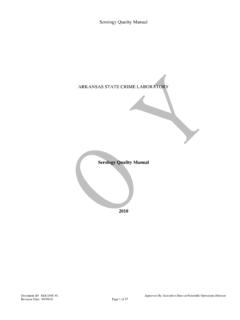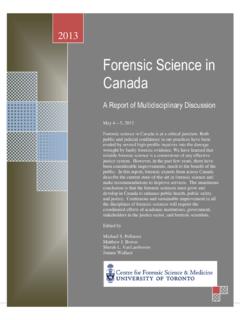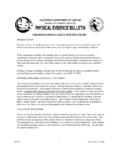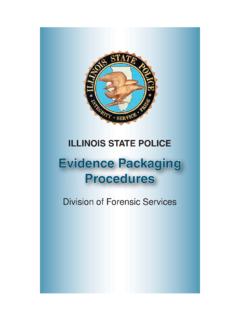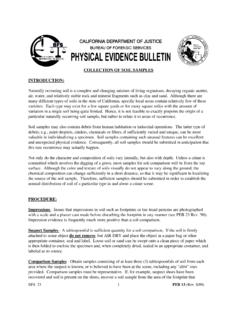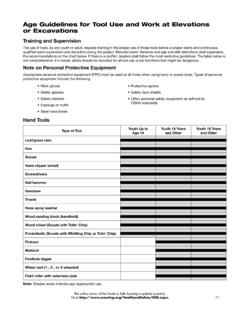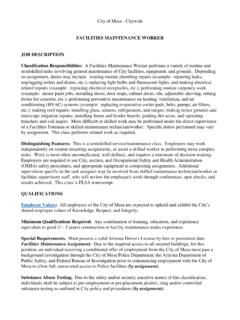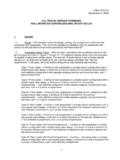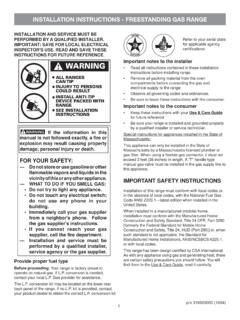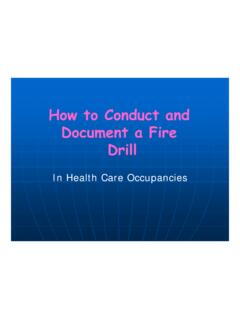Transcription of Firearms and Toolmarks Overview - Crime Scene Investigator
1 Firearms / Toolmarks Overview - 2011 Firearms and Toolmarks Overview The Firearms and Toolmark discipline is a versatile, well-equipped unit offering a number of services that can be useful to investigators. Firearms and Toolmark Examiners are dedicated to providing reliable scientific support to all law enforcement personnel. Services are provided at both the investigation and trial-preparation stages of criminal cases involving the use of a firearm or other tool. The type of weapon that a particular bullet or cartridge case was fired from Whether a bullet was, or was not fired from a suspected weapon Whether a cartridge case was, or was not fired in a suspected weapon Whether a tool found in a suspect s possession was, or was not used to cut, scrape, pry.
2 Or pinch evidence material seized from a Crime Scene * The original serial number of a weapon or other metal object after the number has been obliterated If gunpowder is present on a victim s clothing or on other evidence that may have been the target of the suspect The distance from the muzzle of the firearm to the target at the time the weapon was fired** If fingernail clippings or fragments found at a Scene can be identified as having come from a specific person *Tools found at the Scene of a Crime that cannot be associated with a suspect will not be examined. **No muzzle-to-target distance tests can be done without the weapon that was involved in the shooting.
3 Note: It cannot be determined how long it has been since a weapon was fired. Many other miscellaneous examinations may be performed at the request of the customer. Examiners in the Firearms and Toolmarks discipline may conduct other testing that is of special interest to an Investigator . Such requests may be made at the time of evidence submissions or by phone. Firearms / Toolmarks Overview - 2011 Firearms Analysis Basics of Firearms Comparisons Inside the barrels of handguns and rifles are spiral impressions called rifling. The raised portions of the rifling are known as lands and the recessed portions are known as grooves. When a weapon is fired, these lands and grooves cut into the bullet, putting spin on it as it travels through the barrel of a firearm.
4 Because bullets have an oblong shape, spin is necessary for accurate flight. The impressions of lands and grooves remain on the bullet after it has been fired. Since rifling characteristics can differ from one firearm manufacturer to another, forensic firearm examiners can determine the type of weapon that fired a particular bullet by examining the impressions of the lands and grooves on the bullet. They examine the width, the number, and the direction of the twist of the lands and grooves. For example, a 9mm pistol made by one company might have a barrel with 6 lands and grooves that twist to the right and another company's 9mm might have 6 that twist to the left.
5 In addition, the width of the lands and grooves may differ. Because each barrel will have imperfections left by the manufacturing process that will leave unique marks on a bullet, firearm examiners can determine whether a bullet recovered from a Crime Scene or victim was fired from a weapon taken from a suspect. Firearms / Toolmarks Overview - 2011 Comparison Process The first step in the Comparison Process is to test fire the firearm into a water tank in the lab. Bullets The second step involves using a comparison microscope to compare the test bullet to the bullet recovered from the victim or Crime Scene . The photo on the left shows the split screen image the scientist sees using the comparison microscope.
6 The right side of the photo shows the test bullet fired from the suspect's gun into the water tank and the left side, the bullet recovered from the Crime Scene . The marks or striations on each bullet match, indicating that the two bullets were fired from the same weapon. Cartridge Casings Firearms / Toolmarks Overview - 2011 Since a gun will also leave unique marks on cartridge cases, cases left at Crime scenes can link a suspect's weapon to the Crime . The following photographs of split screen images from a comparison microscope show three different types of markings left on cases that firearm examiners can use in determining if the cases were fired from the same weapons.
7 Firing pin impressions - When a weapon's trigger is pulled, the firing pin is forced into the primer cup located at the rear center of the cartridge. Breech face marks- These marks come from the area surrounding the firing pin of the gun. After the cartridge powder is ignited by the firing pin striking the primer cup, tremendous pressure is exerted in the chamber of the weapon, forcing the back of the cartridge case against the breech face of the weapon. Extractor marks - After a semi-automatic pistol has been fired, an extractor pulls the cartridge from the chamber and ejects it from the pistol. Firearms / Toolmarks Overview - 2011 IBIS The Integrated Ballistic Identification System (IBIS) is used to associate evidence in previously unsolved crimes.
8 IBIS is a highly technical, computerized image analysis system that records striated images from bullets and cartridge cases and compares them to a national, and growing international, database of images. Cartridge cases recovered from victims and Crime scenes are placed into the system and comparisons are made when agencies submit confiscated suspect weapons to the laboratory for testing. The images from the test fires are compared against the entire database. These images can be compared in a very few seconds, an impossible task for a Firearms examiner using conventional procedures. These images are correlated by the IBIS system and given a score as to a possible match.
9 The results of this correlation are called High Confidence Candidates, or HCCs. The Firearms examiner makes a final determination to a positive match which then becomes a Hit. When a Hit has occurred, the involved law enforcement agencies are notified and they can then take the appropriate investigative and legal actions. Toolmark Examination The Firearms and Toolmark discipline receives tools suspected of being associated with a Crime Scene . Cutting, pinching, prying, and striking tools are all examined by this discipline. Great care must be taken by the officer to protect the marking surfaces on the tool. If the entire tool cannot be wrapped, the tool s marking surface should be protected using whatever materials are available to the officer.
10 It should be understood that tools found at the Crime Scene that cannot link a person to the Scene will not be examined. Materials recovered from the Crime Scene that are suspected of being marked by the recovered tool should be carefully removed from the Scene so that the marks are not disrupted. Any cuts made by the officer to remove the suspect areas should be clearly marked so as not to be confused with the suspect areas. Each item should be packaged separately and submitted to the laboratory. Firearms / Toolmarks Overview - 2011 Tools also leave unique marks that can provide important clues in linking a suspect to a Crime . The photo on the right is a split screen comparison of copper wires cut by a wire cutter found in the possession of a burglary suspect.
